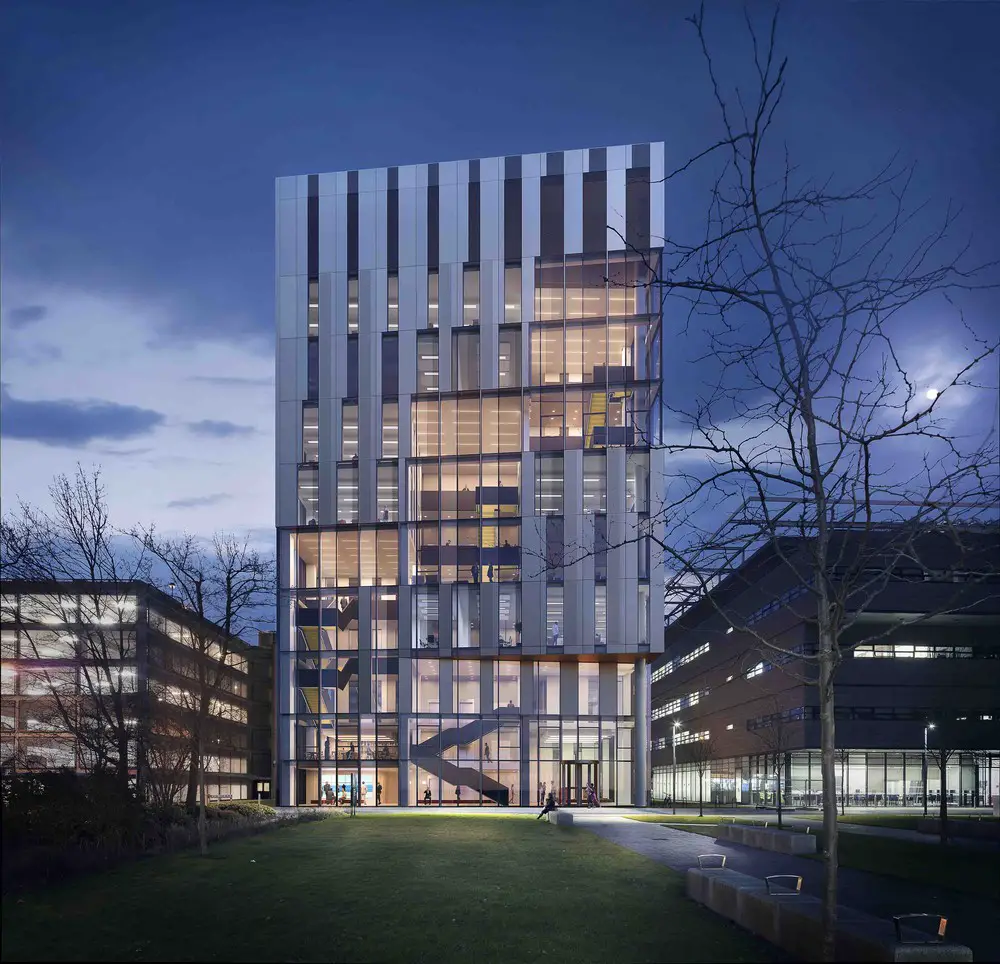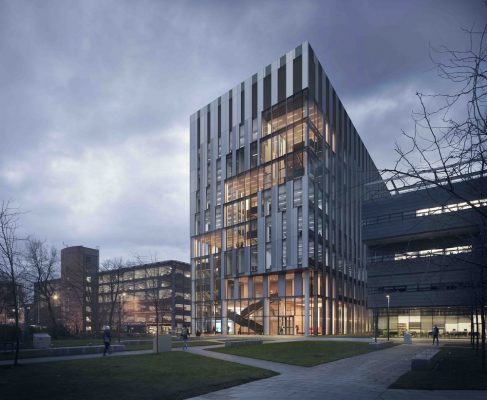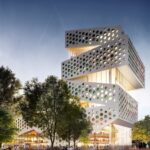Henry Royce Institute Manchester, Advanced Materials Building, Architect, University Hub, Science
Henry Royce Institute
University of Manchester Advanced Materials Hub, Northwest England, UK – design by NBBJ, Architects
29 Nov 2018
Henry Royce Institute Topping Out News
Design: NBBJ Architects
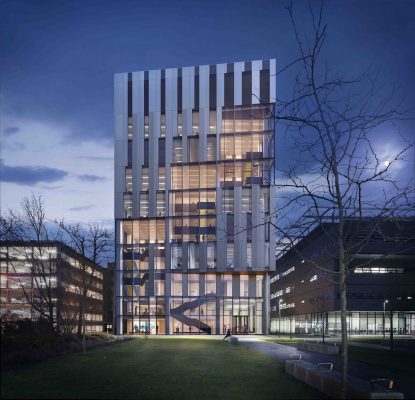
images courtesy of architecture office
Henry Royce Institute for Advanced Materials Hub Manchester
19 Dec 2017
Henry Royce Institute Building
Location: University of Manchester, Manchester, England, UK
Design: NBBJ Architects
Henry Royce Institute, University of Manchester
Construction begins on the national hub of the Henry Royce Institute at The University of Manchester
The UK’s National Institute for materials science research and innovation.
19 December 2017 – Construction work has begun on the Manchester hub for the Henry Royce National Institute, the national body promoting research and applications in advanced materials. The University of Manchester has now entered into contract on the creation of the 46-metres high building which will be a prominent new landmark on the Manchester skyline.
Based at the heart of The University of Manchester’s campus, the Henry Royce Institute for materials science research and innovation will bring together world-leading academics from across the UK to work closely with industry to ensure commercialisation of fundamental research. The development will house world-leading materials scientists, state-of-the-art equipment and provide collaborative and exemplary space for industrial engagement. It is a key part of the University’s ten year Campus Masterplan to create world-class facilities in Manchester.
The Henry Royce Institute will support the Government’s industrial strategy, including investment into the Northern Powerhouse. The report published by the Northern Powerhouse Partnership, a group of businesses, organisations and leaders headed by George Osborne, underlines the pivotal role of the Royce Institute in its potential to integrate collective strengths across the North, creating a centre of excellence that companies and researchers will be able to capitalise on.
The University of Manchester appointed Arcadis as project manager, cost manager and Full Design Team (PMFD) to lead the delivery of the £105 million building. NBBJ, an international architectural practice, has worked with civil and structural engineers Ramboll and building services engineers Arup to create a world-class building design. This building will be delivered by Laing O’Rourke, the appointed main contractor. The institute is expected to be fully operational by early 2020.
The new facility will be based at The University of Manchester to provide a research beacon for the Royce’s founding partners, including The University of Sheffield; The University of Oxford; University of Liverpool; University of Leeds; University of Cambridge; Imperial College London; the UK Atomic Energy Authority (UKAEA); and the National Nuclear Laboratory (NNL).
The Manchester-based building will enable a wide array of ground-breaking research to be undertaken. This includes research into biomedical materials which are at the cutting edge of regenerative medicine and prosthetics; nuclear materials to support the energy sector; materials systems for demanding environments; and 2D materials used in inks for printable electronics, enhanced composites, fuel cells and super capacitators.
Building upon The University of Manchester’s already outstanding reputation for scientific research, the institute will enable the UK to grow its world-leading research and innovation base in advanced materials science and technology.
The University of Manchester Regius Professor Phil Withers, Chief Scientist for the Henry Royce Institute said:
“This new flagship building will be a national beacon of research excellence in advanced materials – not only providing a centre for scientists and engineers to lead on cutting edge research but will also help businesses to apply this new knowledge into technologies for commercial use. Importantly, this hub facility will be a meeting place where colleagues can gather from across the UK and beyond to share their ideas and innovative thinking. This powerhouse development will also support the Government with its industrial strategy and help underpin innovation in the UK economy – regionally and nationally.”
Mel Manku, Partner at Arcadis, said:
“Having led this flagship project of the last two years, we are very pleased to have reached this major milestone on this complex and highly serviced building. To have achieved this on budget is a testimony to our people, our team and the strategic leadership of the University. This success builds on our strong relationship with The University of Manchester following the successful delivery of the National Graphene Institute (NGI) and Schuster Annexe, and the ongoing delivery of the Graphene Engineering Innovation Centre (GEIC). It also recognises our established position in the higher education, science and research sector as a consultant that understands the requirements for research facilities and how to overcome inevitable challenges to deliver value. We appreciate the importance of this nationally significant project and we are privileged to be able to influence the benefits this scheme will bring to Manchester and the UK.”
Liam Cummins, Laing O’Rourke’s Head of UK Building said:
“The Henry Royce building is an exciting and challenging research and education project in a tight and constrained inner city site and will be delivered using modern and innovative methods of engineering and construction with an emphasis on offsite manufacturing and world-class logistical solutions. I am delighted that the contract for the project has now been signed, allowing our team to begin construction in earnest in the New Year. With our colleagues currently making good progress at the Graphene Engineering Innovation Centre; The Henry Royce building becomes the second project that Laing O’Rourke is delivering as part of the University of Manchester Framework.”
Ingo Braun, Design Director at NBBJ, said:
“We are delighted to be working with a world leading institution on a significant project and help contribute in showcasing Manchester’s ground-breaking research, enabling the Institute to play a vital role at the forefront of UK research and innovation. The project builds on NBBJ’s expertise in the design of collaborative workplaces alongside a deep knowledge of the complex requirements of laboratory facilities to provide high-tech buildings.”
Professor Dame Nancy Rothwell, President and Vice-Chancellor at the University, said: “Building upon The University of Manchester’s already outstanding reputation for scientific research, the Royce will enable the UK to grow its world-leading research and innovation base in advanced materials science and technology. It is a great addition to our campus.”
Diana Hampson, Director of Estates and Facilities at the University, said:
“This is one of our major capital projects forming an important part of our vision for the campus and will benefit from its location, close to the National Graphene Institute and the Graphene Engineering Innovation Centre (GEIC).”
Design statement:
The design of the Henry Royce Institute will promote ‘science on show’ with the building forming the centrepiece of laboratories revealing their complex workings, alongside spaces for visitor engagement and imaginative displays of research material and products.
The 10 metre high ground floor entrance is open to the wider university campus and overlooked by a café at mezzanine level. Terraced floors provide visitors with glimpses into workspaces as they climb the staircase through a stepped, three-storey atrium.
These atria house local collaboration hubs with lounge seating and views out across the campus and city beyond. Beyond these is an efficient plan of offices which transition via an adaptable ‘flex zone’ into more private and technical and specialist laboratory spaces.
The façade design communicates the internal working of the building and employs NBBJ’s unique skills in design computation: bespoke software that uses algorithms to link geometry with data to address specific design aspects, allowing rapid prototyping and augmenting an intuitive design process. NBBJ has designed aspects of the project with the help of virtual reality start-up Visual Vocal; a new tool which allows distributed project stakeholders to immerse themselves into unbuilt environments and provide instantaneous feedback to inform a collaborative design process.
With the facades, solar gain is carefully balanced against the building’s spatial functionality; computational ‘rules’ generate greater visual transparency to more ‘open’ functions such as local collaboration hubs, and lesser transparency to controlled laboratory environments, creating a dynamic and modulated building appearance. Researchers and industry partners are linked through a careful arrangement of vertical connections and shared spaces, which additionally offer views into public areas and laboratories for visitors and passers-by.
Background
About NBBJ
NBBJ creates innovative places and experiences for organisations worldwide and designs environments, communities, and buildings that enhance people’s lives. Founded in 1943, NBBJ is an industry leader in designing science, education, corporate, healthcare, commercial, civic and sports facilities. The firm has won numerous awards and has been recognised as one of the largest firms in the annual BD WA survey. NBBJ has more than 750 employees in 11 offices worldwide. Consistently recognised by clients for creative and professional design process, NBBJ has partnered with many top research institutions, corporate and tech companies, including the Wellcome Trust Sanger Institute, King’s College London, Stanford University, the University of Cambridge, Amazon, City University, the Bill & Melinda Gates Foundation, Boeing, GlaxoSmithKline, Microsoft, Salk Institute, Samsung, Telenor, The Royal Liverpool University Hospital and Tencent.
www.nbbj.com
@NBBJDesign
NBBJ Architects
About Arcadis
Arcadis is the leading global Design & Consultancy firm for natural and built assets. Applying our deep market sector insights and collective design, consultancy, engineering, project and management services we work in partnership with our clients to deliver exceptional and sustainable outcomes throughout the lifecycle of their natural and built assets. We are 27,000 people active in over 70 countries that generate €3.4 billion in revenues. We support UN-Habitat with knowledge and expertise to improve the quality of life in rapidly growing cities around the world. Arcadis. Improving quality of life.
About Laing O’Rourke
With a heritage spanning over 160 years, Laing O’Rourke is an internationally-focused engineering enterprise with world-class capabilities. We operate an integrated business model comprising the full range of engineering, construction and asset management services delivering single-source solutions for some of the world’s most prestigious public and private organisations.
Committed to a sustainable future, Laing O’Rourke is re-thinking the way the built environment is designed, delivered and operates – collaborating with world-leading industry and academic partners, bringing innovative new solutions, ensuring the most efficient long-term engineering solutions.
www.laingorourke.com
@laing_orourke
About the Henry Royce Institute
The Henry Royce Institute will be a world-leading centre for advanced materials research and commercialisation.
The £235m project is a hub and spoke model, with the hub at The University of Manchester and spokes at the founding partners, comprising The University of Sheffield; The University of Oxford; University of Liverpool; University of Leeds; University of Cambridge; Imperial College London; the UK Atomic Energy Authority (UKAEA); and the National Nuclear Laboratory (NNL).
Research and industrial collaboration at the Institute is concentrated on nine key areas of materials, and The University of Manchester leads on four of these; Two-dimensional Materials, Materials for Demanding Environments, Nuclear Materials and Biomedical Systems and Devices.
Henry Royce Institute, University of Manchester images / information received 191217
Location: University of Manchester, Manchester, Northwest England, UK
Manchester Buildings
Contemporary Manchester Architecture
Manchester Architecture Walking Tours
Manchester Architecture Offices
The Factory Manchester Building by OMA
Design: OMA
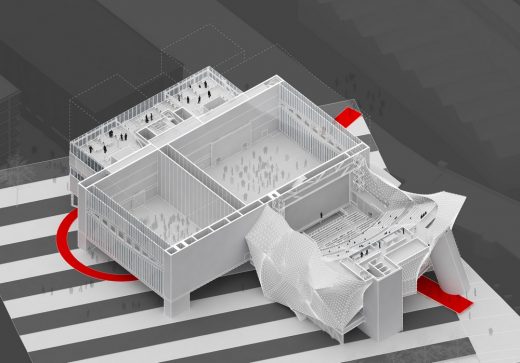
image courtesy of architects
The Factory Manchester Building
Design: Mecanoo architecten

Manchester Arts & Cultural Centre
Factory Theatre Manchester, St John’s quarter
Comments / photos for the Henry Royce Institute, University of Manchester Building page welcome

